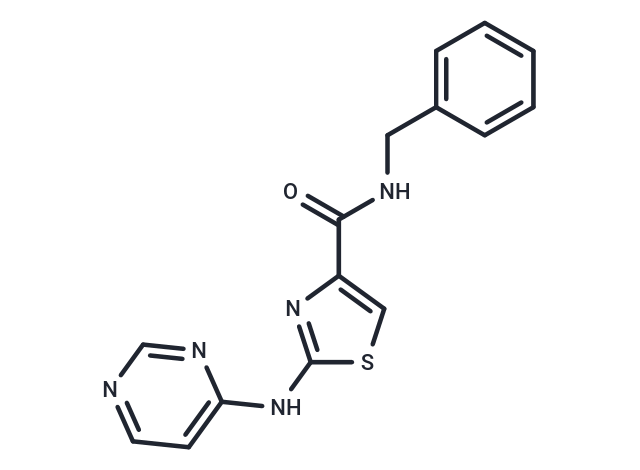Shopping Cart
- Remove All
 Your shopping cart is currently empty
Your shopping cart is currently empty

Thiazovivin, a ROCK inhibitor (IC50: 0.5 μM), increases the survival rate of hESC.

| Pack Size | Price | Availability | Quantity |
|---|---|---|---|
| 2 mg | $44 | In Stock | |
| 5 mg | $68 | In Stock | |
| 10 mg | $117 | In Stock | |
| 25 mg | $222 | In Stock | |
| 50 mg | $401 | In Stock | |
| 100 mg | $597 | In Stock | |
| 1 mL x 10 mM (in DMSO) | $75 | In Stock |
| Description | Thiazovivin, a ROCK inhibitor (IC50: 0.5 μM), increases the survival rate of hESC. |
| Targets&IC50 | ROCK:~0.5 μM (cell free) |
| In vitro | When the cells were cultured in the presence of an E-cadherin blocking antibody, the formation of large, compact aggregates following Thiazovivin treatment was severely inhibited and extensive cell death was observed. Thiazovivin (2 μM) inhibits ROCK activity and protects hESCs at a similar level as Y-27632 (10 μM), a widely used selective ROCK inhibitor [1]. Attachment rates of blastocyst and embryonic cell clumps onto feeder cells in the Thiazovivin treatment group were greater than those of the control group. The pluripotency markers of the OCT4 and NANOG genes and the adhesion molecule E-cadherin were increased by Thiazovivin treatment [2]. By adding thiazovivin to reprogramming cultures, the reprogramming efficiency of CB cells increases by more than 10 times [3]. |
| Kinase Assay | Synthesis of compound immobilized affinity matrixes: Compounds Tzv and its inactive analog (10 mg each) in DMSO (500 μL) and Et3N (10.4 μL) were added to Reacti-Gel (0.5 mL, 25 μmol) that was washed by DMSO in an Eppendorf vial. The reaction mixture was incubated at room temperature until the starting material disappeared (determined by HPLC). After the disappearance of the starting material, ethanolamine (15 μL) was added and the resulting mixture was incubated at room temperature overnight to block the Reacti-Gel. The resulting affinity matrices were washed thoroughly with DMSO (500 μL × 4), PBS (500 μL × 2), and stored at 4 °C in NaN3 solution (0.1% in PBS). Affinity pull-down was performed as described previously. Briefly, whole cell lysates were pretreated with the unfunctionalized affinity matrix at 4 °C for 1.5 h. After washing three times, samples were incubated with the positive or negative affinity matrix at 4 °C for 1 h. After heat shock, samples were loaded and separated on a 4–20% Tris-Glycine SDS PAGE and silver stained with a Silver Stain Plus Kit. The differentially retained protein bands were cut, destained, and analyzed with LCMS [1]. |
| Cell Research | Chemically defined and feeder-free human embryonic stem cell (hESC) culture was described briefly as following. hESCs were grown on Matrigel-coated tissue culture plates in N2B27-CDM [DMEM-F12 supplemented with 1× N2 supplements, 1× B27 supplements, 2 mM L glutamine, 0.11 mM 2-mercaptoethanol, 1× nonessential amino acids, and 0.5 mg/mL BSA (fraction V)] and 20 ng/mL bFGF. Human ESCs were passaged every five to six days with 0.05% trypsin. Murine ESCs are cultured in knockout DMEM supplement with 2 mM L glutamine, 1× nonessential amino acids, 15% serum replacement, and 1 × 10^3 ng/mL leukemia inhibitory factor (LIF). For clonal survival assays, single hESCs were diluted to clonal density and plated onto 96-well Matrigel-coated plate. For low-density survival assays, 500 cells were plated onto 96-well Matrigel-coated plate. To visualize hESC colonies, cultures were fixed in 4% paraformaldehyde in phosphate buffered saline (PBS) for 5 min, washed once in PBS, then stained for alkaline phosphatase (ALP) activity as described in the manufacturer's instructions. ALP-positive colonies were counted on an inverted microscope. For growing hESCs in mouse medium, HES2, HUES7, HUES9, and HUES1-Oct4-GFP were cultured in murine ESC (mESC) growth media supplemented with 1-μM mitogen-activated protein kinase/extracellular signal-regulated kinase kinase (MEK) inhibitor PD0325901 and 5-μM p38 inhibitor SB202190 and 1 × 10^3 human LIF [1]. |
| Molecular Weight | 311.36 |
| Formula | C15H13N5OS |
| Cas No. | 1226056-71-8 |
| Smiles | O=C(NCc1ccccc1)c1csc(Nc2ccncn2)n1 |
| Relative Density. | 1.38 g/cm3 |
| Storage | Powder: -20°C for 3 years | In solvent: -80°C for 1 year | Shipping with blue ice. | |||||||||||||||||||||||||||||||||||
| Solubility Information | DMSO: 60 mg/mL (192.7 mM), Sonication is recommended. | |||||||||||||||||||||||||||||||||||
Solution Preparation Table | ||||||||||||||||||||||||||||||||||||
DMSO
| ||||||||||||||||||||||||||||||||||||

Copyright © 2015-2025 TargetMol Chemicals Inc. All Rights Reserved.